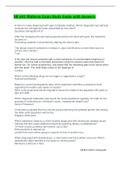College aantekeningen
College aantekeningen van Eigentijdse Geschiedenis
- Instelling
- Rijksuniversiteit Groningen (RuG)
College aantekeningen van Eigentijdse Geschiedenis tot en met week 6. Ik heb ze later nog aangevuld met extra informatie uit de powerpoints, en met de antwoorden van de opdrachten uit de werkcolleges. Volledig in het Engels.
[Meer zien]














